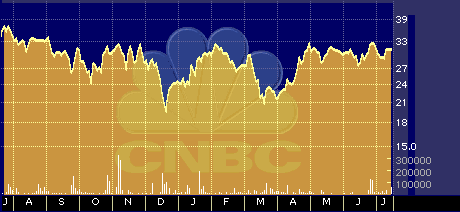
Immersion Corp. Makes a Strong Debut
Immersion Corp. Makes a Strong Debut
by Hal Plotkin
Silicon Valley Correspondent
Immersion Corp.’s {IMMR} stock has debuted strongly Friday, after pricing 4.25 million shares earlier in the afternoon at 12, above its stated range of 9 to 11. The stock has jumped to 17 3/16.
The San Jose, Calif., company gives computer joysticks, steering wheels, and other gaming products a more realistic feel.
“There’s really no alternative to Immersion because of their patents,” says Fred Swan, director of marketing for entertainment products at Swiss company Logitech International Inc. {LOGIY}, which has its operational headquarters in Fremont, Calif.
Immersion has co-developed several products with Logitech, a leading maker of computer mice and other peripherals. The jointly developed products, which use Immersion’s patented “force-feedback” technology, are aimed primarily at the PC gaming market. Logitech’s force-feedback WingMan Joystick, for example, gives users the sensation of resistance when they play aerial combat games, similar to what they might experience in a real cockpit.
“There is virtually nothing any company can do with force-feedback that doesn’t involve Immersion,” Swan says.
Typically, Immersion, which has yet to post a profit, receives product-development fees to work with manufacturers such as Logitech, in addition to a royalty on each device sold.

LOGIY one-year stock performance chart
Sales of computer peripherals containing Immersion’s force-feedback technology have been growing slowly but steadily since the products were introduced in 1996. More than 25 brands, including ACT Labs, ANKO Electronics, Chic, and Rockfire, currently produce products with technology licensed from Immersion.
Accounting for just 10 percent of joystick unit sales, Immersion’s force-feedback segment nonetheless raked in more than 25 percent of the total joystick dollar volume, or about $1.5 million, during June, according to NPD INTELECT, a market tracking firm based in New York.
“[Immersion gets] a little bit more of the pie every month,” says Pat McBride, an account manager at NPD INTELECT. “This is one segment that is maintaining prices and keeping margins up. They’re introducing something new into a pretty static category.”
Check out Immersion’s Web site
The new products include Logitech’s first Immersion-powered force-feedback FEELit mouse, a $99 device aimed primarily at gamers. FEELit mice could also become popular with other computer users as the technology spreads into other applications such as spreadsheets, word processors, and computer-graphics programs. Users of such programs would, for example, be able to feel whenever their cursor is properly positioned over a check-off box, a spreadsheet cell, or the edges of a computer-generated diagram.
“We believe that mice using FEELit technology will revolutionize the way people interact with their computers,” says Wolfgang Hausen, Logitech’s senior vice president.
Others aren’t so sure. Martin Reynolds, an analyst at the GartnerGroup, based in San Jose, Calif., says the current state of force-feedback technology leaves many computer users yawning.
“It’s still very much a nascent technology,” Reynolds says. “It hasn’t lived up to its promise. It could become a part of every PC, or it could just fade away. I’m not seeing anything yet that says, wow, you’ve really got to go out and buy it.”
Immersion, which got its start selling higher-end force-feedback devices, such as surgical simulators, has several other related product lines, including software that allows Web-site operators to add force-feedback features to their Web pages.
While it’s questionable whether a majority of computer users really want mice that fight back, capturing even a small share of the overall mice market could be very lucrative for Immersion and its partners. Somewhere between $8 million and $11 million worth of mice are sold each month.
“Connecting with even a small percentage of that could be substantial,” McBride says. “If you can pick off five to 10 percent, it’s not a bad spot to be in.”
McBride says force-feedback mice are particularly attractive to computer users who divide their time between games and other applications, who will no longer have to switch peripherals to play or work.
Immersion posted a loss of $2.1 million, on revenue of $3.5 million, for the six months ended June 30.


